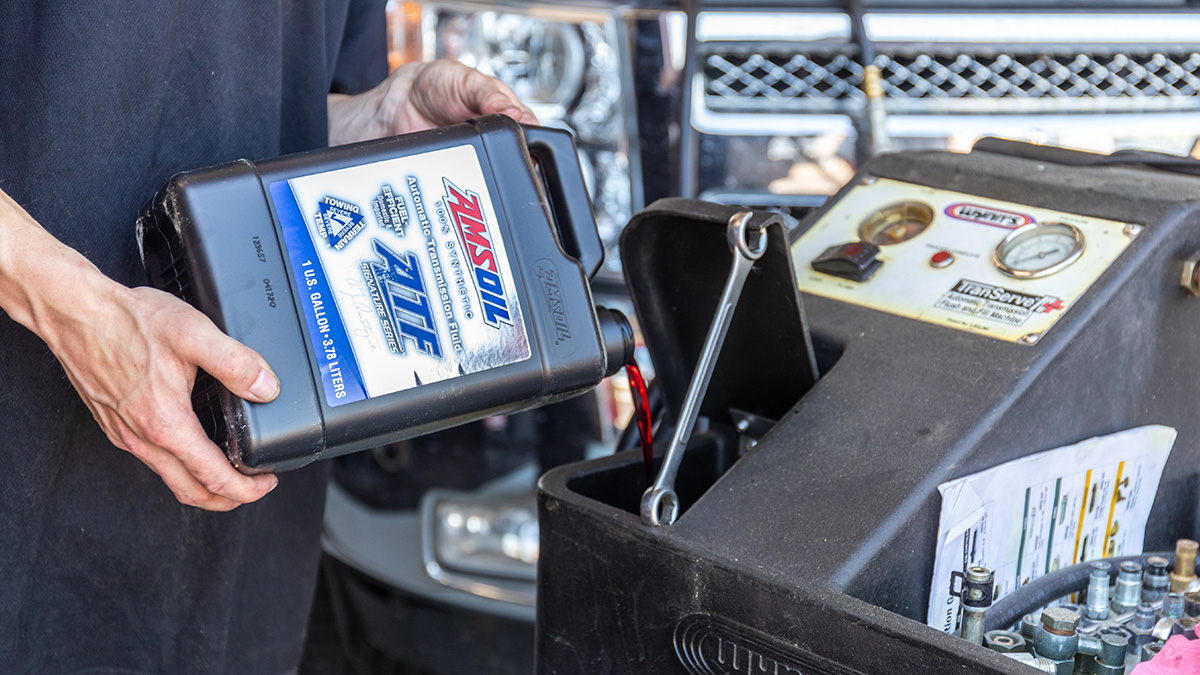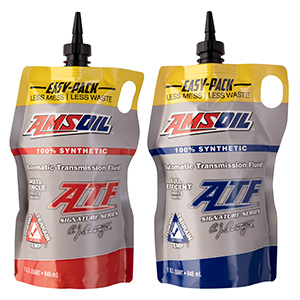Motorists sometimes ask, “How often should I change transmission fluid?” It depends on your vehicle and driving habits. Recommended transmission fluid changes run the gamut from every 30,000 miles (48,000 km) to never. Yeah, that’s right. Here are some tips for determining how often to change transmission fluid.
Change Transmission Fluid: How Often? Check Your Owner’s Manual
Original equipment manufacturer (OEM) recommendations for how often to change automatic transmission fluid cover a wide mileage range, depending on year, make and model.
Plus, if your driving habits are like most motorists and fall under the “severe” designation (towing, hauling, daily short trips less than 10 miles, etc.), many OEMs recommend changing transmission fluid more frequently.
Here are just a few examples to illustrate the disparity among vehicle makes and models.
| Year/Make/Model | Normal Service | Severe Service |
|---|---|---|
| 2021 RAM* 1500 | Never (filled-for-life transmission) | Change if the fluid becomes “contaminated” |
| 2021 Chevy* Silverado* | Never (filled-for-life transmission) | Every 45,000 miles (72,000 km) |
| 2021 Ford* F-150 | 150,000 miles (240,000 km) | 150,000 miles (240,000 km) |
| 2003 Honda* CR-V* | 90,000 miles (145,000 km) | 30,000 miles (48,000 km) |
These differences illustrate the importance of checking the recommendations in your owner’s manual. It’ll provide maintenance recommendations, typically in a table in the back. Many OEMs provide digital owner’s manuals online, so if you’ve lost yours, try a quick search.
A quick word on “filled-for-life” transmissions.
They’re becoming more prevalent as OEMs seek ways to alleviate motorists from unwanted maintenance. They sound like all upside, but it’s important to change fluid in these units, particularly if you tow or haul.
They’re supposed to last the life of the vehicle, but what do you suppose will happen if the transmission fails once the warranty expires? You’re going to get stuck with a hefty repair bill, that’s what. Be proactive and change fluid at least once during its lifetime.
Change Transmission Fluid: How Often? Go By The Book
Follow the recommendations in your owner’s manual.
But, how many of us dutifully follow them down to the mile? Many motorists completely forget about their transmission until it begins to shift hard, jerk or hesitate. Out of sight, out of mind, right?
Not good, especially if you tow or haul.
Heat Kills Transmissions
Over time, transmission fluid oxidizes (chemically breaks down). High heat generated from towing and hauling speeds the process.
Fluid that has broken down can cause sludge and varnish to form, which clogs narrow oil passages and contributes to clutch glazing. Soon, your vehicle can begin to shift poorly.
In these cases, wouldn’t it be great to use a transmission fluid formulated with reserve protection against heat in case life gets in the way of recommended maintenance?
Get Reserve Heat Protection For Your Transmission
AMSOIL Signature Series Synthetic Automatic Transmission Fluid’s built-in reserve protection means it lasts for 2X the OEM’s severe-service drain interval. That means you can rest assured your transmission is protected, even if service is delayed.
Symptoms Of Low Transmission Fluid
It’s not just heat that leads to poor shifting. Low transmission fluid can also present a number of problems, including…
- Inconsistent, jerky shifts
- Hesitation
- Surging
- Increased transmission temperatures
https://blog.amsoil.ca/remember-this-when-trying-to-find-which-transmission-fluid-you-need/
Low Transmission Fluid = Poor Shifting
Transmission fluid serves a number of vital functions, one of which is to act as a hydraulic fluid to enable shifting.
When your vehicle’s computer tells the transmission to change gears, hydraulic pressure (provided by the fluid) squeezes a series of plates together inside a clutch pack to connect the engine to the transmission output shaft and route power to the wheels.
Low fluid can result in the transmission fluid pump drawing air into its inlet. When air and fluid mix, they create foam, which reduces hydraulic pressure and interferes with the crisp, consistent shifts you desire when driving.
Low transmission fluid can also prevent the torque converter from filling completely, which reduces torque transfer and causes hesitation and lost power. In extreme cases, the vehicle won’t even move unless you rev up the engine.
How Much Transmission Fluid Do I Need?
How much transmission fluid your vehicle needs ranges from as few as 8-9 quarts for small passenger vehicles to more than 20 quarts for heavy-duty trucks.
As you do when determining how often to change transmission fluid, check your owner’s manual for the transmission fluid capacity.
You can also check the AMSOIL Product Guide, which shows how much transmission fluid your car needs for most makes and models.
Low Transmission Fluid Can Invite Wear
Transmission fluid also lubricates the gears, clutch plates and seals. It forms a protective layer between meshing gear teeth that prevents metal-to-metal contact and helps reduce wear.
It helps prevent wear on the clutch plates, which bear significant friction during gear shifts. The fluid also lubricates seals and keeps them pliable so they don’t dry out and leak. Find out all the tasks transmission fluid must perform here.
Low fluid can prevent formation of a strong, consistent lubricating film on components, inviting wear. Foam bubbles can collapse when they pass between gear teeth, allowing metal-to-metal contact and further accelerating wear.
Check Your Transmission Fluid
To keep your vehicle running – and shifting – at peak performance, check the fluid about once a month to ensure the correct level. Check out this post on how to check your transmission fluid. If the fluid is consistently low, visit a mechanic to find out why and have the problem fixed.
So, when determining how often to change transmission fluid, follow the recommendations in your owner’s manual. For added peace of mind in case you surpass those recommendations, you can rely on AMSOIL synthetic transmission fluid to deliver reserve protection.








I have a 2014 Tacoma 4×4 auto with 25,000 miles on the clock. It’s my first automatic (always had manuals previously which I changed out at 25,000 religiously). My dealer shop foreman keeps refusing to service it. It’s one of those with no dipstick or way to examine the fluid. He keeps telling me that Toyota vacuum seals their traines and that it would be a waste of money. It has not towed during it’s life, but does have a high volume of short trips. I’ve trusted all my vehicles, including motorcycles, for years with Amsoil with very good results. I’m hoping you can give me some good info pertaining to what is the best way to proceed with my Taco?
Hi Allen,
Your transmission contains a drain plug and a fill plug, similar to a differential, so it is possible to change the fluid. It can be a tricky process, though, so we recommend visiting a professional. The bottom line, though, is it can be done. Just visit a different dealership or an independent transmission shop.
Thanks for reading.
I did not realize that most cars do not even have a dipstick for checking transmission fluid. It is also good to realize that sometimes transmission fluid is in a hard to access area. Regular maintenance visits would be a good thing to do for your car. A mechanic could help you solve small problems before they become larger issues.
I have been asking the same question. Now I know. Thanks for sharing.
Hi! I own a 2006 Toyota Corolla CE which comes from my Dad who can’t drive anymore because of his old age. An excellent car which I think that it will last again for sevral years if I take good care of it by following the maintenance schedule.
Only one thing, as the transmission fluid has never never been changed, I’m thinking of changing it very soon. So what I like to know, is Amsoil synthetic automatic transmission fluid better than the one which is sold at a Toyota dealer? I’m asking you that because whenever I can I’ve always bought the best oils and fluides for my cars in order for them to last the longest time possible and also avoid the most possible car problems weather in my driveway or when on a street or highway.
So, knowing that I’ll be hearing of you very soon, I would like to Thank you very much in advance for your information. Have a good day!
YVES LAVOIE from Drummondville Québec Canada
Hi Yves,
Thanks for your interest in AMSOIL. I have a Corolla myself, and it’s a great little car.
While we don’t have test results showing the performance of AMSOIL synthetic automatic transmission fluid compared to Toyota’s OEM-branded fluid, we have something better, in my opinion – results of severe-service testing we performed in a fleet of Las Vegas taxi cabs. After more than 180,000 miles of severe driving in the scorching desert heat of Las Vegas, AMSOIL Signature Series Synthetic Automatic Transmission Fluid guarded against wear and damaging sludge and delivered flawless performance. Click the link above to view the images of the transmission teardown and see for yourself.
If the fluid performed that well in Las Vegas taxi cabs, think of how great it will perform in your Corolla.
Thanks for reading.
Hi John,
I have a 2001 Honda Odyssey with 237,000 miles and original transmission. It has developed a delayed shift from 1-2 and sometimes a quick shift to 3rd. The fluid was changed in December 2016 with Honda fluid. Any thoughts or suggestions to extend the life of the transmission and/or improve its performance?
Hi Jason,
237K is getting up there. We wrote a post about common fixes for a transmission that jerks or hesitates. In essence, start by checking the fluid level. It could be low. Other possibilities include worn out fluid that has lost its frictional properties and fluid with poor cold-flow properties (which likely isn’t the problem if it’s happening in May).
I hate to be the bearer of bad news, but the tranny may just be wearing out. Like I said, 237,000 miles is a lot, especially if your haul or pull a trailer once in a while.
If it were my vehicle, I’d start by checking the fluid. Ensure it’s not low and examine its condition. If it’s black and appears burned, try changing it before visiting the dealership. In my experience, going to the dealership with a faulty tranny is just asking for a $2,500-plus estimate to fix it. Start with the cheap fixes first!
Thanks for reading,
John
I was wondering if I can safely mix factory AT4 and Amsoil synthetic transmission fluid? Since the drain and filter change keeps about 50% of the original fluid in the tranny.
Hi Cory,
AMSOIL Synthetic Transmission Fluid is compatible with other transmission fluids recommended for the same specifications. Yes, you can safely mix the two.
Thanks,
John
Check your torque converter for a drain plug. Lots of cars have a drain on them. You may have to turn the engine to find it. Check your manual for more info.
Thanks for pointing out the reasons due to which transmission fluid loses its ability of lubrication. Transmission fluid plays a vital role in the performance of the transmission by providing a friction less surrounding to various components of the vehicle. However, transmission fluid loses its ability of lubrication over time due to above-mentioned factors. Use of burned transmission fluid could bring the vehicle to a halt. So, the condition of the transmission fluid should be inspected regularly and if necessary replace such lubricant after certain time interval as recommended in the owners manual.
Some manufacturers have taken this “lifetime” transmission fluid too far. Even gotten rid of drain plugs, dipsticks and such. Now requires specialized machinery to perform a simple transmission fluid change.
Unacceptable. No fluid of any type lasts a lifetime. It’s purely a marketing gimmick, speeds the assembly process and reduces manufacturing cost.
I’ve given up on automatic transmissions as a result. Give me a stick! Besides the vehicle control aspect of a stick, it serves as a theft deterrent (millennials don’t know what to do with that third pedal).